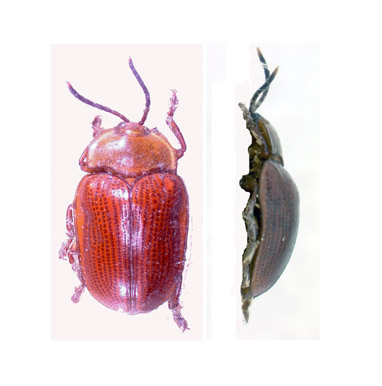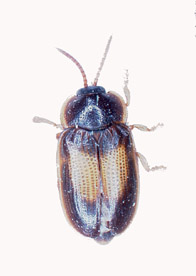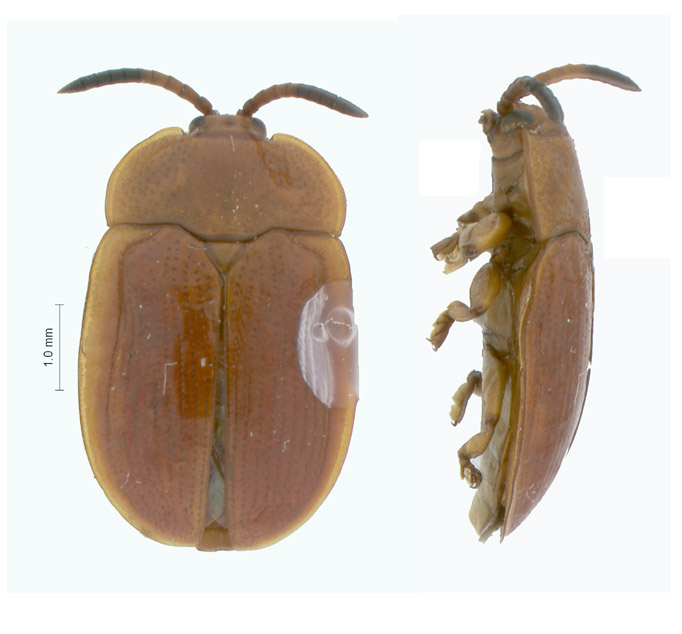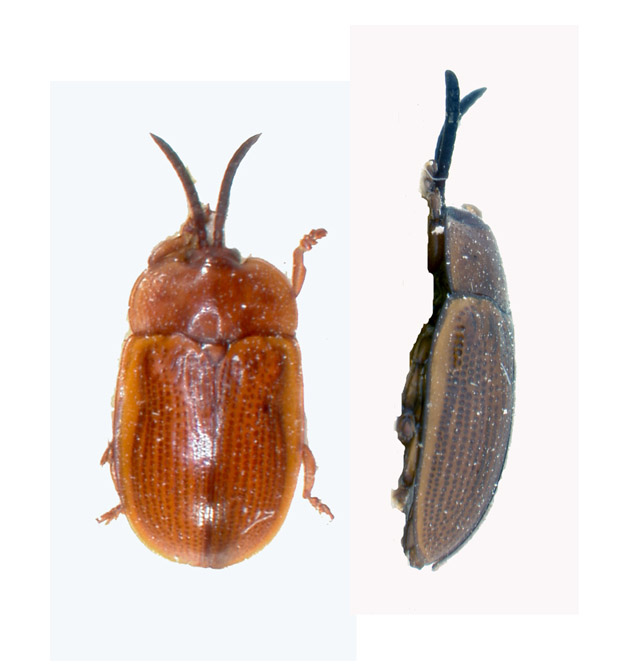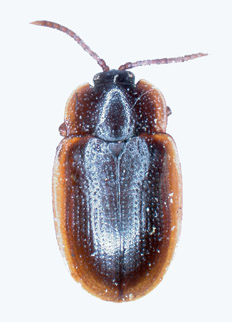Demotispa
|
Demotispa pallida |
|
Demotispa neivai |
|
Demotispa gomescosti |
|
Demotispa florianoi |
|
Demotispa elaeicola |
|
Demotispa bonadri |
|
Demotispa pici |
Introduction
Demotispa Baly (Coleoptera: Chrysomelidae: Cassidinae) contains 28 species from Central and South America (Staines 2012) and is in need of revision. The genus has for years been a dumping ground for species which belonged in several different genera (Staines 2009). Little biological work has been done on Demotispa species but six species have been associated with palms. Bondar (1940a, b, 1941, 1942) and Genty & Mariau (1973) has studied the life history of Demotispa neivai and Flowers & Chaboo (2009) published feeding records for Demotispa elaeicola.
Distribution
Demotispa bondari (Spaeth) is found in Brazil (Bahia).
Demotispa elaeicola (Aslam) is found in Colombia and Ecuador.
Demotispa florianoi (Bondar) is found in Brazil (Bahia).
Demotispa gomescostai (Bondar) is found in Argentina and Brazil (Rio Grande do Sul).
Demotispa neivai (Bondar) is found in Brazil (Bahia) and Peru.
Demotispa pallida Baly is found in Brazil, Colombia, and French Guyana.
Demotispa pici Staines (=Cephaloleia limbata Pic) is found in Argentina and Uruguay.
Hosts
Demotispa bondari feeds on palms (Spaeth 1938); Cocos nucifera L. (Bondar 1940b), and Geonoma sp. (Bondar 1940b) (Arecaceae).
Demotispa elaeicola feeds on Elaeis guineenis Jacq. (Arecaceae) (Aslam 1965).
Demotispa florianoi feeds on Cocos coronata Mart. (Bondar 1942) and Washingtonia filifera (Linden ex André) H. Wendl. (Silva et al. 1968) (Araceaceae).
Demotispa gomescostai (Bondar) Arecastrum romanzoffianum Cham., Cocos eriospatha Mart., Phoenix canariensis Hort. ex. Chabaud, Washingtonia filifera (Linden ex André) H. Wendl. (Bondar 1943); Phoenix roebelinii O’Brien, Pritchardia filamentosa H. Wendl. (Monrós & Viana 1947); Phoenix humilis Royle (Silva et al. 1968); Ph. roebeleni O’Brien, and Ph. dactylifera L. (Risbec 1950a) (Arecaceae).
Demotispa neivai feeds on Cocos botryophora Mart. (Bondar 1940a); Areca sp., Bactris sp., Cocos nucifera L., Desmoncus polyacanthus Mart., Elaeis guineensis Jacq., Licuala sp., Livistona sp. (Bondar 1941); Areca bambu [sic], Bactris setosa Mart. (Silva et al. 1968); and Astrocaryum tucumoides Drude (Ferreira et al. 1998) (Arecaceae).
Demotispa pallida feeds on Elaeis guineensis Jacq. (Mariau 1999); Bactris gasipaes K. (Mora et al. 1997); Astrocaryum carnosum Kahn & Millán, A. chonta Martius (Couturier & Kahn 1992); and A. vulgare Mart. (Couturier et al. 1999) (Arecaceae).
Demotispa pici Staines feeds on Arecastrum romanzoffiana (Bosq 1943) and Phoenix canariensis (Monrós & Viana 1947) (Arecaceae).
Damage
Adults and larvae are often observed on the lower surface of young leaves, but the feeding damage is not usually serious. This results in feeding channels running 5-6 mm wide parallel to leaf veins and turning brown over time.
Adults and larvae feed on clustered fruit rasping the skin starting at the apex and causing scarring. The feeding channels are 4-5 mm wide and in heavy infestations can run together. This results in drying of the epicarp and prevents the fruit from maturing properly. The damage also exposes the fruit to fungal attack. Beetles prefer plants less than 6 years old.
Life history notes
Adults and larvae are not leaf miners but live between the individual green fruits in the cluster. Pupation occurs at the base of the fruit. Adults of D. elaeicola are present throughout the year but are more common at the beginning of the rainy season.
Eggs are laid singly and are without protection. Newly hatched larvae are semitransparent and white. They darken to gray as they mature. Pupae are formed within the last larval exuvium.
Bibliography
Aslam, N. A. 1965. On Hispoleptis Baly (Coleoptera, Hispidae) and Imatidium F. (Coleoptera, Cassididae). The Annals and Magazine of Natural History (13 8: 687-693.
Bondar, G. 1940a. Notas entomológicas da Bahia. V. Revista de Entomologia Rio de Janeiro 11: 199-214.
Bondar, G. 1940b. Crisomelideos nocivos ao coqueiro- Genero Himatidium. O Campo 11 (125): 12-13.
Bondar, G. 1941. Notas entomológicas da Baía. VII. Revista de Entomologia Rio de Janeiro 12: 268-303.
Bondar, G. 1942. As cêras no Brasil e o licuri Cocos coronata Mart. na Bahia. Tipografia Naval Bahia. 86 pp.
Bondar, G. 1943. Notas entomológicas da Baía. XIII. Revista de Entomologia Rio de Janeiro 14: 337-388.
Bosq, J. M. 1943. Segunda lista de coleópteros de la República Argentina, dañinos a la agricultura. Ministerio de Agricultura de la Nación, Direccion de Sanidad Vegetal, División de Zoología Agrícola de "Ingeniería Agronómica" Buenos Aires 4 (18-22). 80 pp.
Couturier, G. & F. Kahn. 1992. Notes on the insect fauna on two species of Astrocaryum (Palmae, Cocoeae, Bactridinae) in Peruvian Amazonia, with emphasis on potential pests of cultivated palms. Bulletin de l’Institut Français d’Etudes Andines 21 (2): 715-725.
Couturier, G., M. S. Padiha de Oliveira, & P. Beserra. 1999. Entomofauna fitófaga em palmeiras natives da Amazônia. Embrapa Pesquisa em Andamento 2: 1-3.
Ferreira, J. M. S., D. R. N. Warwick, & L. A. Siqueira. 1998. A cultura do coqueiro no Brasil. Empresa Brasileira de Pesquisa Agropecuária. Brasília. 2nd edition. 292 pp.
Flowers, R. W. & C. S. Chaboo. 2009. Novel host records of some cassidine leaf beetles from Ecuador (Coleoptera: Chrysomelidae: Cassidinae). Insecta Mundi 0095: 1-8.
Genty, P. & D. Mariau. 1973. Les ravageurs et maladies du palmier à huile du cocotier. Le genre Himatidium. Oléagineux 28 (11): 513-515.
Monrós, F. & M. J. Viana. 1947. Revisión sistemática de los Hispidae Argentinos (Insecta, Coleop. Chrysomeloid.). Anales del Museo Argentino Ciencias Naturales "Bernardino Rivadavia" 42: 125-324.
Mora-Urpí, J., J. C. Weber, & C. R. Clement. 1997. Peach palm, Bactris gasipaes Kunth. Promoting the conservation and use of underutilized and neglected crops 20. International Plant Genetic Resources Institute. Gatersleben, Germany. 82 pp.
Risbec, J. 1950. Les Hispidae des plantes cultivées. Revue Internationale de Botanique Appliquée et d’Agriculture Tropicale 30: 378-396.
Silva, A., C. R. Gonçalves, D. M. Galvâo, A. J. L. Gonçalves, J. Gomes, M. do Mascimento Silva, & L. de Simoni. 1968. Quarto catálogo dos insetos que vivem nas plantas do Brasil seus parasitos e predadores. Ministério da Agricultura, Departmento de Defesa e Inspeção Agropecuária. Rio de Janeiro. 622 pp.
Spaeth, F. 1938. Die Gattung Himatidium Fabr. (Col. Cassidinae). Revista de Entomología Rio de Janiero 9: 305-317.
Staines, C. L. 2009. Generic reassignment of species in the tribe Cephaloleiini Chapuis, 1875 (Coleoptera: Chrysomelidae: Cassidinae). Insecta Mundi 0107: 1-4.
Staines, C. L. 2012. Tribe Imatidiini. Catalog of the hispines of the world (Coleoptera: Chrysomelidae: Cassidinae). http://entomology.si.edu/Collections_Coleoptera.html


